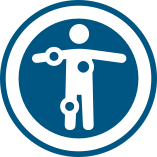Understanding your advanced prostate cancer (APC)
Helping you understand the journey from diagnosis to treatment
Every patient’s journey is different, and understanding your symptoms and test results may seem overwhelming.
Always remember to talk to your treatment team if you have any questions about your APC.

Common prostate cancer symptoms4
- Blood in the urine or semen
- Difficulty getting an erection (erectile dysfunction or ED)
- Pain in the hips, back, chest, or other areas from cancer that has spread to bones
- Weakness or numbness in the legs or feet
- Loss of bladder or bowel control
- Problems urinating such as the urge to urinate more often or a slow or weak urinary stream, especially at night
An overview of advanced prostate cancer
Prostate cancer in the US5:

Total number of
estimated new cases

Percentage diagnosed
at the local stage

Median age
at diagnosis

Percentage alive 5 years
after initial diagnosis
APC testing
As part of a patient’s diagnosis, there are a variety of tests that may be given to better understand a patient’s treatment needs. Some tests may be repeated throughout your treatment to monitor how well they are working. Ask your doctor for regular updates to check your progress.
Gleason scoring system
The Gleason system, which has been in use for many years, assigns grades based on how much the cancer looks like normal prostate tissue.4
Pathologists will determine a patient’s Gleason score by examining tissue samples from a prostate biopsy and comparing the cancer tissue pattern with normal tissue. The higher the score, the more likely the cancer is to spread.6
What does my Gleason score mean?
2-6
Low Grade4
Cancer is likely to grow and spread slowly
7
Medium Grade4
Cancer is likely to grow but may not spread quickly
8+
High Grade4
Cancer is likely to grow and spread more quickly
Most cancers are grade 3 and above; grades 1 and 2 are not often used4
Have A Voice
Every month is an opportunity for you to connect with your treatment team
Make monthly visits matter by getting involved in your treatment plan.